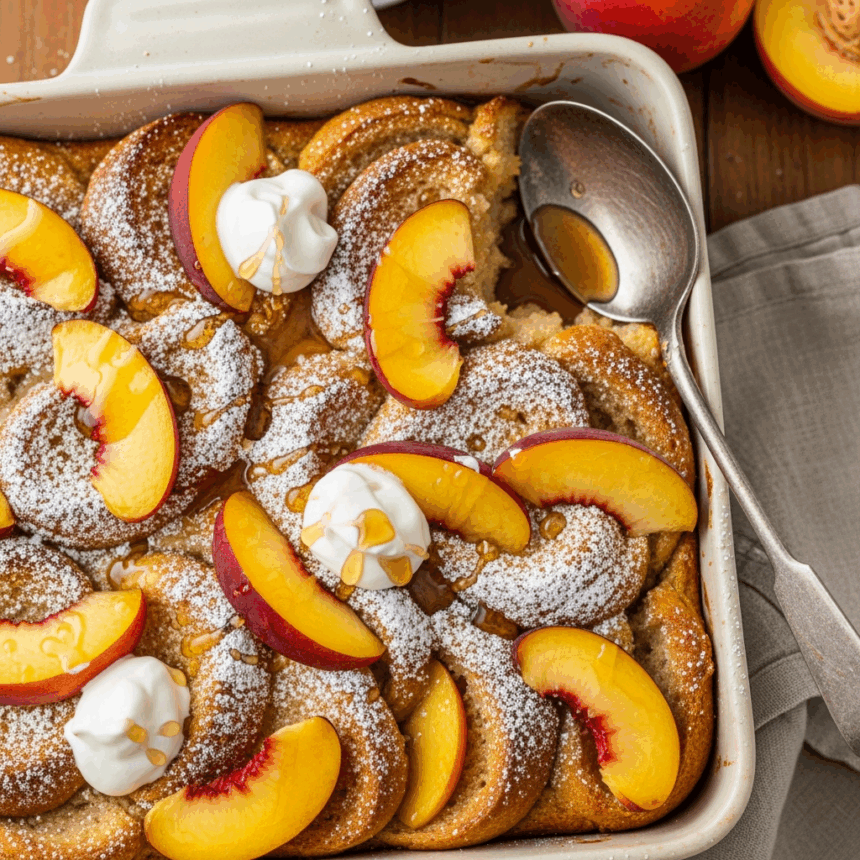Ever had that moment where you’re standing in front of your fridge thinking, “I want something sweet and fancy but also don’t want to put on real pants to go to a restaurant”? Well, grab those pajama bottoms and that forgotten loaf of bread because we’re about to change your brunch game forever with a peach-filled French toast casserole that screams “I have my life together” while actually requiring minimal effort.
Why This Recipe is Awesome
Let me count the ways this French toast casserole will revolutionize your morning routine. First off, you prep it the night before when you actually have energy (or motivation, whichever shows up first). Second, it’s basically impossible to mess up—seriously, if you can operate a measuring cup and know how to crack an egg without fishing out shell pieces, you’re qualified. Third, it feeds a crowd without making you flip individual bread slices like some short-order cook. And finally, peaches. Need I say more? Fresh, juicy peaches transform ordinary French toast into something that would make your grandmother secretly jealous.
Ingredients You’ll Need
Round up these suspects:
- 1 large loaf of day-old bread (French, brioche, or challah—basically anything that once cost more than $2)
- 8 large eggs (the fresher the better, but we don’t judge)
- 2 cups of whole milk (or whatever milk-adjacent liquid you have)
- ½ cup heavy cream (because we’re not here to count calories, people)
- ¾ cup granulated sugar (divided—don’t dump it all in at once, rookie)
- 2 teaspoons vanilla extract (the real stuff, not that imitation nonsense)
- 1 teaspoon cinnamon (more if you’re a cinnamon fiend like me)
- ¼ teaspoon nutmeg (freshly grated if you’re fancy, pre-ground if you’re normal)
- 4-5 ripe peaches, sliced (or 4 cups frozen if peaches aren’t in season—we’re practical here)
- 3 tablespoons butter, melted (unsalted, but salted works if that’s all you’ve got)
- Optional: ¼ cup brown sugar for topping (because why not?)
Step-by-Step Instructions
- Prep your baking dish. Grab a 9×13-inch baking dish and grease it like you’re afraid of commitment. Nothing sticks to excessive butter.
- Cube that bread. Cut your bread into 1-inch cubes. Stale bread works best here, but if yours is fresh, just spread the cubes on a baking sheet and pop them in a 200°F oven for 10 minutes. We’re looking for dry, not toasted.
- Create your egg mixture. In a large bowl, whisk together eggs, milk, cream, ½ cup sugar, vanilla, cinnamon, and nutmeg until well combined. This is not the time for lumps, folks.
- Build your base layer. Put half the bread cubes in your prepared baking dish, then layer half the peach slices on top. Repeat with remaining bread and peaches, creating a carby-peachy lasagna of sorts.
- Pour that custard. Slowly pour the egg mixture over the bread and peaches, making sure to hit every piece. Press down gently with a spatula to help absorption. The bread should soak up the mixture like your skin soaks up a compliment—eagerly and completely.
- Rest and reflect. Cover with plastic wrap and refrigerate for at least 4 hours, but preferably overnight. This resting time is non-negotiable—like that friend who needs a solid 8 hours or becomes a monster.
- The next morning: Preheat your oven to 350°F and remove the casserole from the refrigerator to take off the chill.
- Add the finishing touches. Mix the melted butter with the remaining ¼ cup sugar and optional brown sugar, then drizzle over the casserole.
- Bake to golden perfection. Pop it in the oven for 45-55 minutes until the center is set and the top is golden brown. If it starts browning too quickly, tent with foil—we want glamorous, not burned.
- Rest (again). Let it cool for 10 minutes before serving. I know it’s hard to wait, but your taste buds (and the roof of your mouth) will thank you.
Common Mistakes to Avoid
Let’s avoid turning your masterpiece into a disaster, shall we?
- Using fresh, soft bread without drying it. You’ll end up with soggy casserole that resembles bread pudding’s unfortunate cousin.
- Skipping the overnight soak. Patience is a virtue, especially in French toast casserole. Without proper soaking time, you’ll have dry bread swimming in egg soup.
- Overcrowding the peaches. Yes, they’re delicious, but too many will release too much liquid and turn your casserole into peach soup. Not that I’d complain, but still.
- Forgetting to grease the dish. Unless you enjoy chiseling breakfast off your baking dish like an archaeologist, butter that dish generously.
- Opening the oven every 5 minutes to check. I get it—the anticipation is killing you. But your oven loses 25°F every time you open it, so hands off!
Alternatives & Substitutions
Life happens. Ingredients go missing. Here’s how to pivot:
- Fruit options: Not a peach person? Blasphemy, but I’ll allow it. Try berries, apples, pears, or even bananas. Frozen fruit works great in the off-season (just thaw and drain excess liquid).
- Bread choices: Any substantial bread works here. Cinnamon raisin bread adds a twist, and yes, even that forgotten hot dog bun can join the party in desperate times. Just don’t tell anyone I said that.
- Milk alternatives: Almond, oat, or coconut milk all work here. The casserole doesn’t discriminate, though it may take on subtle flavor notes.
- Sugar substitutes: Honey, maple syrup, or even brown sugar can replace white sugar. Each brings its own personality to the party.
- Add-ins: Feeling adventurous? Throw in some cream cheese chunks, a handful of nuts, or even a sprinkle of cardamom. It’s your kitchen kingdom—rule it how you want.
FAQ (Frequently Asked Questions)
Can I make this ahead and freeze it?
You bet! Assemble everything up to the baking step, cover tightly, and freeze for up to a month. Thaw overnight in the fridge before baking. Your future self will high-five you.
How long does this stay good in the fridge?
About 3-4 days, assuming you have that level of willpower. Reheat individual portions in the microwave or the whole thing (covered) in a 300°F oven.
Can I use canned peaches if I can’t find fresh or frozen?
Technically yes, but drain them super well. Like, give them a therapy session where they release all their excess liquid. Otherwise, you’ll have soggy casserole syndrome, and nobody wants that.
My casserole looks too dry/too wet. What did I do wrong?
Too dry? Your bread probably didn’t soak long enough, or your bread-to-liquid ratio was off. Too wet? You either used too much liquid or didn’t use enough bread. FYI, French toast casserole should be moist but not swimming.
Do I really need the heavy cream?
Do you really need that extra episode of your favorite show at 11 PM? No, but it makes life better. You can use all milk, but the cream adds richness that’ll make you close your eyes and sigh happily with each bite.
What can I serve with this?
Bacon. Always bacon. Also, a light fruit salad if you’re feeling virtuous, or just more syrup if you’re being honest with yourself.
Final Thoughts
There you have it—a French toast casserole that’s basically an edible hug for your taste buds. It’s impressive enough for company but easy enough for a random Wednesday when you need something special. The beauty of this dish is in its forgiving nature—much like your best friend who still loves you after seeing your questionable dance moves.
So go ahead, whip this up tonight, sleep while the magic happens, and wake up to a breakfast that’ll make you wonder why you ever waited in line at that trendy brunch spot. Your pajama-clad self deserves this deliciousness, and honestly, so does everyone else lucky enough to be at your table. Now go forth and casserole!



